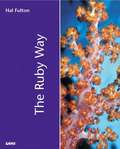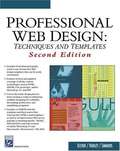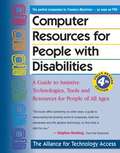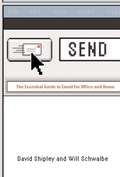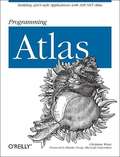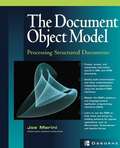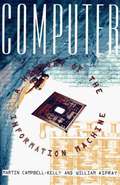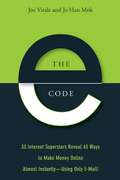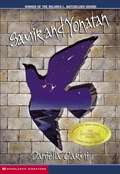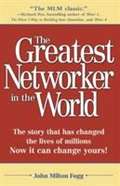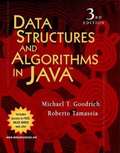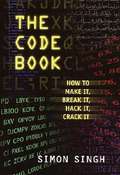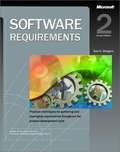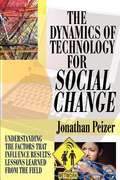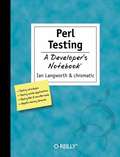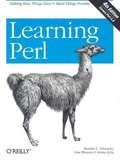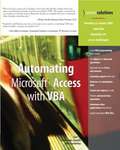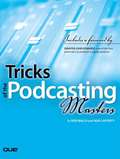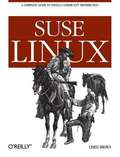- Table View
- List View
The Ruby Way
by Hal FultonThe Ruby Way takes a "how-to" approach to Ruby programming with the bulk of the material consisting of more than 400 examples arranged by topic. Each example answers the question "How do I do this in Ruby?" Working along with the author, you are presented with the task description and a discussion of the technical constraints. This is followed by a step-by-step presentation of one good solution. Along the way, the author provides detailed commentary and explanations to aid your understanding.
Professional Web Design (2nd Edition)
by Eric Hunley Erik Simmons Clint EccherThe current state of Web design is in a transitory phase. The latest push is for the use of "standards" set out by the World Wide Web Consortium (W3C). These standards were created so that different browsers will display Web pages in the same, or at least very similar manner. One of the most important elements to these standards has been the increased popularity and usage of Cascading Style Sheets (CSS). Cascading Style Sheets were created as a means to separate markup from presentation, which results in cleaner code. Because of the immense importance of CSS, the coverage in this book has been increased with a complete chapter dedicated to them. Ultimately, Web design is headed to using pure CSS for all presentation and layout of Web pages. However, at this point, the use of CSS is not quite ready to take over completely. Browsers do not have sufficient support, and the language is still growing. The only way that designers can be certain that a page looks as close as possible to what is intended is through the use of tables. That is the main focus of this edition. The first edition introduced the idea of mortising and the use of nested tables for layout. This edition continues with that, but adds more information about CSS, client-side scripting with JavaScript, and server-side scripting with PHP as sites are growing with the amount of content they are serving. This edition can be seen as a bridge to the future. It explores the traditional methods of table-based design, but introduces more CSS, which will ultimately take over.
Computer Resources for People with Disabilities
by Alliance for Technology AccessA resource for people with disabilities who want to improve their lives through the use of technology.
Send: The Essential Guide to Email for Office and Home
by David Shipley Will SchwalbeThe hows and whys of using email, and how to communicate effectively.
Programming Atlas
by Christian WenzIn the past year, developers worldwide have embraced the Ajax combination of technologies (Asynchronous Javascript and XML) as a way to build web applications that deliver users a more desktop-like experience. Now, in an effort to simplify Ajax development, especially for ASP.NET 2.0 developers, Microsoft has introduced a new framework, code-named "Atlas", that is loaded with tools, templates and controls that simplify the creation of Ajax savvy web pages that are richer, more interactive, and more personalized, as well as standards-based and able to run cross browser. Programming Atlas Rough Cuts provides experienced web developers with an exciting hands-on tour of "Atlas," beginning with an introduction to the Ajax technologies behind it all, from JavaScript, and XMLHttpRequest to JSON. Author Christian Wenz then unpacks the "Atlas" framework and shows how to use it to create Ajax-enabled web sites. Dozens of examples demonstrate how to use core "Atlas" controls and extenders, how to bind and display data, and how to draw on the power of Microsoft Web 2.0 services such as Microsoft Virtual Earth and Windows Live. The book will be especially useful to web developers who are new to Ajax, regardless of their current platform, and its combination of well-explained examples and reference material, concisely presented, makes the concepts of this new framework accessible to developers of various technical levels. Recently updated for the April CTP release of "Atlas", the book now includes a new chapter on the shared source "Atlas" Control Toolkit!
The Document Object Model: Processing Structured Documents
by Joe MariniThe DOM is a standard for organizing and manipulating documents, eg. web pages in an internet browser.
Use ClickOnce to Deploy Windows Applications
by Wei-Meng LeeClickOnce, a new technology in Visual Studio 2005, lets you quickly and easily deploy your Windows apps via web servers, file servers, or even CDs. But while ClickOnce delivers web-style deployment of your application, that's only part of the story. Once you've installed an application using ClickOnce, it can automatically check for new updates to the application, which saves time in application maintenance and upgrades. And on the security front, a ClickOnce application runs within a secure sandbox and you configure it using the Code Access Security model. So, how can you take advantage of this new technology? In this step-by-step guide to using ClickOnce, you'll learn how to create an application in Visual Studio 2005 and how to use ClickOnce to quickly get it in the hands of your customers. You'll also learn how to add security to your distributions using Code Access Security; how to update COM files without corrupting DLLs; and more.
Crystal Fire: The Invention of the Transistor and the Birth of the Information Age (Sloan Technology Series)
by Michael Riordan Lillian Hoddeson"With impeccable scholarship and meticulous research, this book covers an impressive sweep of history from the discovery of the electron to the first integrated circuit. ... A definitive account of the birth of the semiconductor industry." -London Daily Telegraph "In rich detail, Riordan and Hoddeson unfurl the development of the transistor and the lives of its three principal discoverers- John Bardeen, Walter Brattain, and William Shockley. . . . Standing on the shoulders of giants while harvesting the fruits of their own astonishing research, the triumvirate of the transistor created the device that has revolutionized life today, making possible television, computers, and other electronic devices." -Library Journal
Computer: A History of the Information Machine
by Martin Campbell-Kelly William AsprayBlending strong narrative history and a fascinating look at the interface of business and technology, Computer: A History of the Information Machine traces the dramatic story of the invention of the computer. More than just the tale of a tool created by scientists to crunch numbers, this book suggests a richer story behind the computer's creation, one that shows how business and government were the first to explore the unlimited potential of the machine as an information processor. Not surprisingly, at the heart of the business story is IBM. A story of old-fashioned entrepreneurship in a symbiotic relationship with scientific know-how, it begins way back when "computers" were people who did the computational work of scientists, and Charles Babbage attempted in vain to mechanize the process. But it also shows how entrepreneurs like Herman Hollerith, seeing a business opportunity in a machine that could mechanically tabulate the U.S. census, created a punched-card tabulator that became the technology that created IBM. The authors show how ENIAC, the first fully electronic computer, emerged out of the wartime need of the military for computers that performed at lightning speed and did not need human intervention at any stage of the process. Most interesting is the story of how the computer began to reshape broad segments of our society when the PC enabled new modes of computing that liberated people from dependence on room-sized, enormously expensive mainframe computers. Filled with lively insights-many about the world of computing in the 1990s, such as the strategy behind Microsoft Windows-as well as a discussion of the rise and creation of the World Wide Web, here is a book no one who owns or uses a computer will want to miss.
The E-Code
by Joe Vitale Jo Han MokBusiness on the internet is gaining in popularity. With low overhead and start-up costs, people are able to create businesses that prosper. In this book, some of the leading internet marketers show you how to use the power of e-mail to collaborate on projects, sell products without spamming anyone, and how to find people who are genuinely interested in your products. This is a practical book for people who are ready to take their business to the next level. It is also a great roadmap for people who want to do business online but don't know where to start.
Windows Vista Secrets®
by Brian Livingston Paul ThurrottFrom the book: Part I Surviving Setup Part II Understanding the Windows Vista User Experience Part III Security Part IV Digital Media and Entertainment Part V Mobility Part VI Internet and Networking Part VII Home Office/Power User
The Wave Three Way To Building Your Downline
by Richard PoeThe face of home business has changed in recent years. People are building businesses based on good products, treating each other well, and using the power of internet technology. Now millions of people just like you are learning to make a living from home. In this book you'll find dozens of stories of people from soccer moms to beach bums and fortune 500 executives and how they learned to make a living from home. They show you how you can too.
Samir and Yonatan
by Daniella Carmi Yael LotanSamir, a Palestinian boy, worries about entering a Jewish hospital in Israel for a knee operation because Jewish soldiers are the enemy who killed his older brother. His healing is more than physical. On the children's ward, Yonatan becomes Samir's friend and offers him new ways of thinking.
Microsoft in the Mirror: Nineteen Insiders Reflect on the Experience
by Karin CarterFormer and current employees of Microsoft share their experience.
The Greatest Networker in the World
by John Milton FoggJohn Fogg shares his experiences. His techniques will change how you approach networking for ever. This book addresses the differences between conventional marketing and multilevel marketing.
Data structures and Algorithms in Java: 3rd edition
by Micheal T. Goodrich Roberto TamassiaThis edition is designed to provide an introduction to data structures and algorithms, including their design, analysis, and implementation. <P><P><i>Advisory: Bookshare has learned that this book offers only partial accessibility. We have kept it in the collection because it is useful for some of our members. Benetech is actively working on projects to improve accessibility issues such as these.</i>
The Code Book: How to Make it, Break it, Hack it, Crack it
by Simon SinghIt's known as the science of secrecy. Cryptography: the encoding and de coding of private information. And it is history's most fascinating story of intrigue and cunning. The battle between codemakers and codebreakers has been going on for centuries: from Julius Caesar and his Caesar cipher to the codebreaking achievements of the tenth-century Arabs; from the code used by Mary Queen of Scots in an attempt to dethrone Elizabeth I to Sir Francis Walsingham's decipherment of that code, which led to Mary's execution for treason; from the Germans' use of the Enigma machine for automatic encryption in the Second World War to Alan Turing's efforts to infiltrate Enigma, which contributed to the Allied victory. And the battle rages on. How private are your e-mail communications? How secure is sending your credit card information over the Internet? And how much secrecy will the government tolerate? Simon Singh follows the evolution of secret writing with a clarity that lets the reader enjoy the captivating story while easily absorbing the details of cryptography. Woven throughout are clear and concise illustrations of the processes of enciphering and deciphering. Accessible, compelling and timely, this international bestseller, now adapted for young people, is sure to make readers see the past- and the future-in a whole new way.
Software Requirements (2nd edition)
by Karl E. WiegersPractical techniques for gathering and managing requirements throughout the product development cycle
The Dynamics of Technology for Social Change: Lessons Learned from the Field
by Jonathan PeizerTopics include: Sector dependencies, collaboration dynamics, information and communication technology challenges; nonprofit capacity issues and promising approaches; balancing the profit and value motive; implementation strategies; marketing and promotion strategies.
Perl Testing: A Developer's Notebook
by Ian LangworthIs there any sexier topic in software development than software testing? That is, besides game programming, 3D graphics, audio, high-performance clustering, cool websites, et cetera? Okay, so software testing is low on the list. And that's unfortunate, because good software testing can increase your productivity, improve your designs, raise your quality, ease your maintenance burdens, and help to satisfy your customers, coworkers, and managers. Perl has a strong history of automated tests. A very early release of Perl 1.0 included a comprehensive test suite, and it's only improved from there. Learning how Perl's test tools work and how to put them together to solve all sorts of previously intractable problems can make you a better programmer in general. Besides, it's easy to use the Perl tools described to handle all sorts of testing problems that you may encounter, even in other languages. Like all titles in O'Reilly's Developer's Notebook series, this "all lab, no lecture" book skips the boring prose and focuses instead on a series of exercises that speak to you instead of at you. Perl Testing: A Developer's Notebook will help you dive right in and: Write basic Perl tests with ease and interpret the results Apply special techniques and modules to improve your tests Bundle test suites along with projects Test databases and their data Test websites and web projects Use the "Test Anything Protocol" which tests projects written in languages other than Perl With today's increased workloads and short development cycles, unit tests are more vital to building robust, high-quality software than ever before. Once mastered, these lessons will help you ensure low-level code correctness, reduce software development cycle time, and ease maintenance burdens. You don't have to be a die-hard free and open source software developer who lives, breathes, and dreams Perl to use this book. You just have to want to do your job a little bit better.
Learning Perl, 4th Edition
by Randal L. Schwartz Tom Phoenix Brian D. FoyLearning Perl , better known as "the Llama book", starts the programmer on the way to mastery. Written by three prominent members of the Perl community who each have several years of experience teaching Perl around the world, this latest edition has been updated to account for all the recent changes to the language up to Perl 5.8. Perl is the language for people who want to get work done. It started as a tool for UNIX system administrators who needed something powerful for small tasks. Since then, Perl has blossomed into a full-featured programming language used for web programming, database manipulation, XML processing, and system administration--on practically all platforms--while remaining the favorite tool for the small daily tasks it was designed for. You might start using Perl because you need it, but you'll continue to use it because you love it. Informed by their years of success at teaching Perl as consultants, the authors have re-engineered the Llama to better match the pace and scope appropriate for readers getting started with Perl, while retaining the detailed discussion, thorough examples, and eclectic wit for which the Llama is famous. The book includes new exercises and solutions so you can practice what you've learned while it's still fresh in your mind. Here are just some of the topics covered: data structures minimal matching threading data parsing references objects modules package implementation If you ask Perl programmers today what book they relied on most when they were learning Perl, you'll find that an overwhelming majority will point to the Llama. With good reason. Other books may teach you to program in Perl, but this book will turn you into a Perl programmer.
Automating Microsoft Access with VBA
by Mike Gunderloy Susan Sales HarkinsProgramming Microsoft Access using the Visual Basic for Applications (VBA) language.
Tricks of the Podcasting Masters
by Rob Walch Mur LaffertyThis book gives detailed instructions for putting together your own podcasts. It also reviews the history of podcasting. Everything you ever wanted to know about podcasts is probably here.
SUSE Linux: A Complete Guide to Novell's Community Distribution
by Christopher R. BrowningSUSE Linux: A Complete Guide to Novell's Community Distribution will get you up to speed quickly and easily on SUSE, one of the most friendly and usable Linux distributions around. From quick and easy installation to excellent hardware detection and support, it's no wonder SUSE is one of the most highly rated distributions on the planet. According to Novell, SUSE is installed more than 7,000 times every day, an average of one installation every 12 seconds. This book will take you deep into the essential operating system components by presenting them in easy-to-learn modules. From basic installation and configuration through advanced topics such as administration, security, and virtualization, this book captures the important details of how SUSE works--without the fluff that bogs down other books and web sites. Instead, readers get a concise task-based approach to using SUSE as both a desktop and server operating system. In this book, you'll learn how to: Install SUSE and perform basic administrative tasks Share files with other computers Connect to your desktop remotely Set up a web server Set up networking, including Wi-Fi and Bluetooth Tighten security on your SUSE system Monitor for intrusions Manage software and upgrades smoothly Run multiple instances of SUSE on a single machine with Xen Whether you use SUSE Linux from Novell, or the free openSUSE distribution, this book has something for every level of user. The modular, lab-based approach not only shows you how--but also explains why--and gives you the answers you need to get up and running with SUSE Linux. About the author: Chris Brown is a freelance author and trainer in the United Kingdom and Europe. Following Novell's acquisition of SUSE, he taught Linux to Novell's consultants and IT staff and is certified in both Novell's CLP program and Red Hat's RHCE. Chris has a PhD in particle physics from Cambridge.
